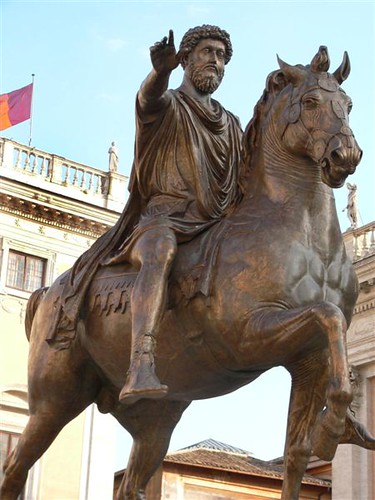
A beautiful horse head with traces of gilt has been retrieved from a well near Waldgrimes in central Germany. Archaeologists speculate that the horse was part of an equestrian statue bearing the emperor Augustus that was ritually destroyed by Germanic tribesmen after their victory over Roman legions at Teutoburg Vald in 9 C.E. The rider's foot was also recovered.
It would be wonderful if enough fragments could be found to reconstruct the work. There is only one other equestrian statue of Augustus known in the world at this time. Sadly, equestrian statues contained so much bronze that they were prized targets of medieval recyclers so few Roman period equestrian statues survive intact. It is said that the famous equestrian statue of Marcus Aurelius at the Capitoline Museum in Rome only survived because it was thought to be Constantine I, revered by early Christians for making Christianity the official religion of the empire. Judging from the picture provided by the Science Ministry of Hessen (above left), the Augustan statue must have been as breathtaking as the Aurelian statue in Rome (right). The horse's bridle

depicts figures of Mars, the Roman god of war, and Nike, personification of victory.
Previous excavations at Waldgrimes have yielded a Roman forum, lead waterpipes and a retail center. The statue may have been the centerpiece of a cult temple of Augustus. Such a temple was erected in Lugdunum by Drusus as a transitory step to making Gaul a Roman province following suppression of a revolt over a Roman census there. As a symbol of Romanization, it would have naturally been a target following news of the successful ambush by Arminius.
Panic swept through Roman settlements in Germania and Gaul.
"After the defeat of Varus there was panic throughout the Roman population living in Gaul and
Germany.
Most of the forts established by Drusus and Tiberius in
Germany were abandoned immediately after the disaster.
All but one of the Roman garrisons stationed in
Northern Germany was destroyed, with only the garrison at Aliso holding out.
Dio describes the events which surrounded Aliso.
Aliso has been tentatively identified as the base Haltern.
Haltern, a Roman legionary base in
Germany illustrates the panic that spread through the Romans in
Germany.
Haltern, founded in 5 BC, is situated about 54 km from Vetera on the north bank of the
Lippe River, where the river has its confluence with the
Stever River.
Haltern may have served as the wintering quarters for Varus and his legions in the winter 9 AD.
The fort supported a large number of troops and had all the logistical and administrative support that a large force of soldiers would require to function.
The amount of housing for officers is unusually high at Haltern implying that the post served as an administrative hub for the Roman army deployed east of the
Rhine River. Dio attributes the Romans success at Haltern to German ignorance of siege warfare and Roman employment of archers.
The archers held the Germans off, inflicting heavy losses on the Germans.
Nevertheless the Romans soon ran out of supplies and had to make an escape attempt.
Using a rainstorm and darkness as cover the Romans slipped out and met up with Roman forces to the west.
Archeological evidence from Haltern shows that it was hastily abandoned around 9 AD as shown by the tremendous amount of buried hordes throughout the fort.
Romans fleeing to the
Rhine, not wanting to be slowed down with material goods, buried several hordes around the fort in anticipation of retrieving them again.
These hordes consist primarily of weapons and coinage.
Other Roman bases on the Lippe were similarly abandoned: Anreppen, Oberaden, and Holsterhausen.
" - Rome’s Bloody Nose: The Pannonian Revolt, Teutoburg Forest and the Formation of Roman Frontiers by Nolan Doyle, Western Oregon University.
We've all heard of Augustus' response - rending his clothes and crying out "Varus, give me back my legions!" But Augustus was not just being melodramatic. Cassius Dio writes, "... there were no more men available in reserve.
The Roman armies had reached the point of breaking, between the rebellions in
Pannonia and
Germany the losses could not be easily replaced anymore.
Augustus had to resort to conscriptions of men and nobody wanted to be conscripted. Augustus made the men draw lots with twenty percent of those under the age of thirty-five and ten percent of those older conscripted into the army.
When people still were not excited enough to be conscripted Augustus had several men executed.
Augustus also called up veterans and conscripted freedmen and put them into service.
" - Rome’s Bloody Nose: The Pannonian Revolt, Teutoburg Forest and the Formation of Roman Frontiers by Nolan Doyle, Western Oregon University.
For a graphic view of the battle of Teutoburg Forest, check out
these videos on YouTube, excerpts from the History Channel series "Decisive Battles."
Hopefully, we'll learn even more about this tumultuous period with continued excavations.






